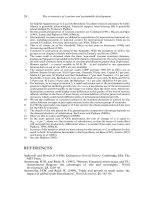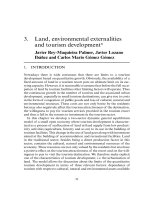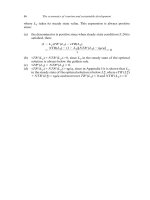THE ECONOMICS OF MONEY,BANKING, AND FINANCIAL MARKETS 166
Bạn đang xem bản rút gọn của tài liệu. Xem và tải ngay bản đầy đủ của tài liệu tại đây (39.63 KB, 1 trang )
134
PA R T I I
Financial Markets
upward-sloping yield curve indicates that short-term interest rates are predicted to
rise in the future, and a downward-sloping yield curve indicates that short-term
interest rates are predicted to fall. However, a financial institution manager needs
much more specific information on interest-rate forecasts than this. Here we show
how the manager of a financial institution can generate specific forecasts of interest rates using the term structure.
To see how this is done, let s start the analysis using the approach we took in
developing the expectations theory. Recall that because bonds of different maturities are considered perfect substitutes, we assumed that the expected return over
two periods from investing $1 in a two-period bond, which is (1 i2t) (1 i2t) 1,
must equal the expected return from investing $1 in one-period bonds, which is
(1 it) (1 i et 1) 1. This is shown graphically as follows:
Today
0
1
Year
1
it
(1
1
i2t ) (1
i et
Year
2
1
i2t )
In other words,
it)(1
(1
i et 1)
1
(1
i2t )(1
i2t )
1
Through some tedious algebra we can solve for i et 1:
(1 i2t)2
1
(4)
1 it
This measure of i et 1 is called the forward rate because it is the one-period interest rate that the pure expectations theory of the term structure indicates is
expected to prevail one period in the future. To differentiate forward rates derived
from the term structure from actual interest rates that are observed at time t, we
call these observed interest rates spot rates.
Going back to the Application Expectations Theory and the Yield Curve
(p. 124), which we used to discuss the expectations theory earlier in this chapter,
at time t the one-year interest rate is 5% and the two-year rate is 5.5%. Plugging
these numbers into Equation 4 yields the following estimate of the forward rate
one period in the future:
i et
i et
1
11 + 0.05522
1
1 + 0.05
1
0.06
6%
Not surprisingly, this 6% forward rate is identical to the expected one-year interest rate one year in the future. This is exactly what we should find, as our calculation here is just another way of looking at the pure expectations theory.
We can also compare holding the three-year bond against holding a sequence
of one-year bonds, which reveals the following relationship:
(1
it )(1
i et
)(1
1
i et
and plugging in the estimate for i et
i et
2
)
2
1
=
1
(1
i3t )(1
i3t )(1
i3t )
1
derived in Equation 4, we can solve for i et 2:
11 + i 3 t23
11 + i 2 t22
- 1









